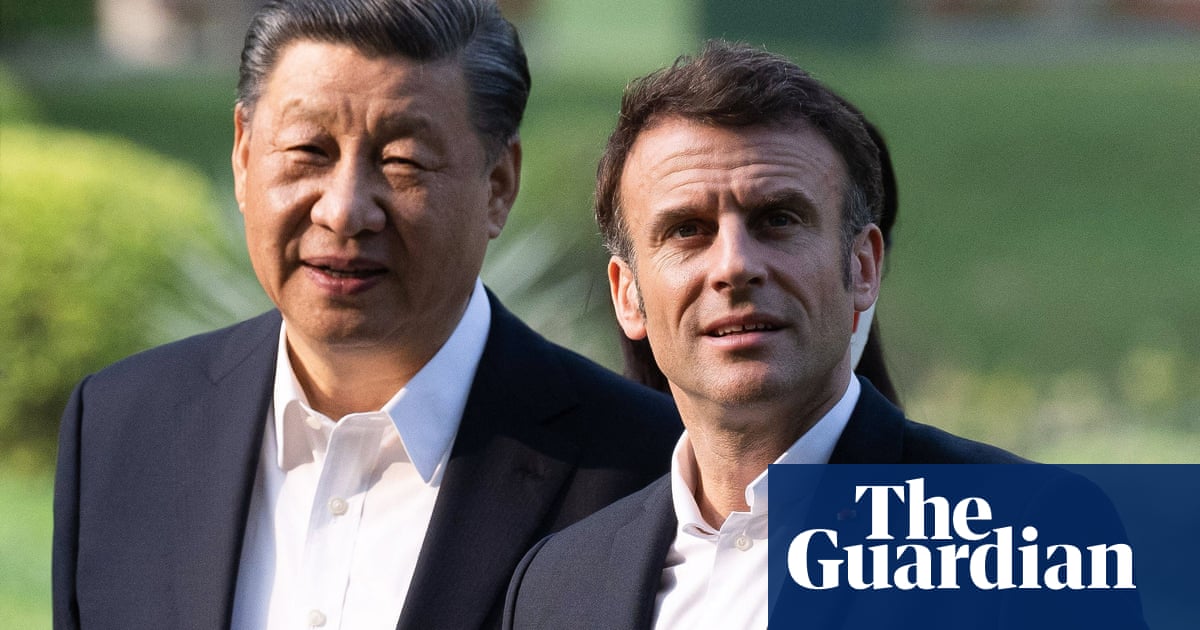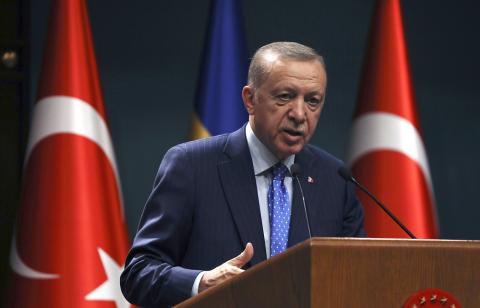
With everything going on in the world, it is not difficult to understand why there is a debate inside NATO about what role the alliance should play when it comes to China.
Some policymakers argue that, for NATO to remain relevant, it must get more involved in the Indo-Pacific region and make China a top priority. However, this is easier said than done.
Those advocating that NATO take on China fail to see how divisive this issue is inside the alliance. For example, there was only one sentence devoted to China in the lengthy joint statement released the last time the leaders of NATO met in London in December 2019. Admittedly, this was the first time that NATO had mentioned China by name as a “challenge.” However, in the same sentence, it also described Beijing as an “opportunity” for the alliance.
This does not mean that the members of NATO do not have legitimate concerns about China’s activities. Beijing’s attempts, through technology giant Huawei, to fund and integrate itself into certain parts of Europe’s digital infrastructure is a concern. This is particularly relevant to the ongoing debate in Europe about fifth-generation (5G) wireless technology.
China’s increasing investments in critical infrastructure — especially ports and rail — is also a concern for many in Europe. Its delays at the onset of the coronavirus disease (COVID-19) outbreak, which led to a global pandemic costing trillions of dollars and more than 2.5 million dead, has made many in the West question its trustworthiness and honesty.
Understandably, these are all issues that keep US and European policymakers up at night. However, NATO is, first and foremost, a collective security organization that is committed to protecting the territory of its member states from military aggression, according to the 1949 North Atlantic Treaty, “in the North Atlantic area north of the Tropic of Cancer.” As an intergovernmental alliance founded on collective security, NATO lacks many of the regulatory, trade, legislative and economic tools required to confront China.
On the military front, which is closer to NATO’s core competency, it is true there is an increasing coziness between China and Russia on defense cooperation. However, in reality, Russian-Chinese military cooperation in NATO’s area of responsibility has been limited.
In 2015, three ships from the Chinese People’s Liberation Army Navy (PLAN) joined six ships from the Russian Navy in the Eastern Mediterranean for a naval exercise that lasted five days. This was the first time the two countries had carried out such an exercise and, at the time of writing, the only time in the Mediterranean Sea.
In 2017, a Chinese destroyer, frigate and supply ship visited Kaliningrad as part of an exercise that lasted eight days. Again, this was the first and only such military exercise in the Baltic Sea. In 2018, China’s participation in Russia’s large-scale Vostok military exercise received considerable media attention. However, Beijing only contributed just over 3,000 soldiers (1 percent) of the 300,000 that participated in the exercise. And China’s military presence during the exercise was confined to the regions east of Lake Baikal.
Therefore, to address China, NATO can do three reasonable and responsible things. First, push member states to do more when confronting some of Beijing’s non-military threats. Some of the biggest challenges posed by China to NATO’s member states relate to investments in critical infrastructure, disinformation campaigns, and encroachments in the technology sector. NATO should not pretend to lead on an issue for which it lacks the needed policy competencies. Therefore, only the national capitals, and in some cases the EU, have the political and economic tools that can reduce the economic and political threats posed by China.
Secondly, NATO should not let itself be distracted from the Russian threat. With the investments in critical infrastructure, the fallout of the COVID-19 pandemic and the ongoing 5G debate in Europe, it is no surprise that China is a major concern for Western policymakers — and rightly so. However, for NATO, the immediate threat, and the threat for which it was created and for which it has the tools, is Russia. NATO should focus primarily on this threat.
Thirdly, NATO needs to be realistic about the Chinese military threat facing the alliance in the North Atlantic area. As already stated, Russian-Chinese military activity in NATO’s area of responsibility has amounted to two different training exercises spanning a total of 13 days and consisting of a total of six PLAN ships over the course of the past six years. While NATO should monitor Russian-Chinese military cooperation, it must recognize that its No. 1 priority remains Russia.
NATO should not get distracted by China
NATO Alliance leaders during the annual NATO heads of government summit at the Grove Hotel in Watford, Britain, Dec. 4, 2019. (Reuters)
Short Url
https://arab.news/zqr2b
With everything going on in the world, it is not difficult to understand why there is a debate inside NATO about what role the alliance should play when it comes to China.
Some policymakers argue that, for NATO to remain relevant, it must get more involved in the Indo-Pacific region and make China a top priority. However, this is easier said than done.
Those advocating that NATO take on China fail to see how divisive this issue is inside the alliance. For example, there was only one sentence devoted to China in the lengthy joint statement released the last time the leaders of NATO met in London in December 2019. Admittedly, this was the first time that NATO had mentioned China by name as a “challenge.” However, in the same sentence, it also described Beijing as an “opportunity” for the alliance.
This does not mean that the members of NATO do not have legitimate concerns about China’s activities. Beijing’s attempts, through technology giant Huawei, to fund and integrate itself into certain parts of Europe’s digital infrastructure is a concern. This is particularly relevant to the ongoing debate in Europe about fifth-generation (5G) wireless technology.
China’s increasing investments in critical infrastructure — especially ports and rail — is also a concern for many in Europe. Its delays at the onset of the coronavirus disease (COVID-19) outbreak, which led to a global pandemic costing trillions of dollars and more than 2.5 million dead, has made many in the West question its trustworthiness and honesty.
Understandably, these are all issues that keep US and European policymakers up at night. However, NATO is, first and foremost, a collective security organization that is committed to protecting the territory of its member states from military aggression, according to the 1949 North Atlantic Treaty, “in the North Atlantic area north of the Tropic of Cancer.” As an intergovernmental alliance founded on collective security, NATO lacks many of the regulatory, trade, legislative and economic tools required to confront China.
On the military front, which is closer to NATO’s core competency, it is true there is an increasing coziness between China and Russia on defense cooperation. However, in reality, Russian-Chinese military cooperation in NATO’s area of responsibility has been limited.
In 2015, three ships from the Chinese People’s Liberation Army Navy (PLAN) joined six ships from the Russian Navy in the Eastern Mediterranean for a naval exercise that lasted five days. This was the first time the two countries had carried out such an exercise and, at the time of writing, the only time in the Mediterranean Sea.
In 2017, a Chinese destroyer, frigate and supply ship visited Kaliningrad as part of an exercise that lasted eight days. Again, this was the first and only such military exercise in the Baltic Sea. In 2018, China’s participation in Russia’s large-scale Vostok military exercise received considerable media attention. However, Beijing only contributed just over 3,000 soldiers (1 percent) of the 300,000 that participated in the exercise. And China’s military presence during the exercise was confined to the regions east of Lake Baikal.
Therefore, to address China, NATO can do three reasonable and responsible things. First, push member states to do more when confronting some of Beijing’s non-military threats. Some of the biggest challenges posed by China to NATO’s member states relate to investments in critical infrastructure, disinformation campaigns, and encroachments in the technology sector. NATO should not pretend to lead on an issue for which it lacks the needed policy competencies. Therefore, only the national capitals, and in some cases the EU, have the political and economic tools that can reduce the economic and political threats posed by China.
Secondly, NATO should not let itself be distracted from the Russian threat. With the investments in critical infrastructure, the fallout of the COVID-19 pandemic and the ongoing 5G debate in Europe, it is no surprise that China is a major concern for Western policymakers — and rightly so. However, for NATO, the immediate threat, and the threat for which it was created and for which it has the tools, is Russia. NATO should focus primarily on this threat.
Thirdly, NATO needs to be realistic about the Chinese military threat facing the alliance in the North Atlantic area. As already stated, Russian-Chinese military activity in NATO’s area of responsibility has amounted to two different training exercises spanning a total of 13 days and consisting of a total of six PLAN ships over the course of the past six years. While NATO should monitor Russian-Chinese military cooperation, it must recognize that its No. 1 priority remains Russia.
While the alliance should monitor Russian-Chinese military cooperation, it must recognize that its No. 1 priority remains Russia.
Luke Coffey
NATO should also keep an eye on other military threats in its region. For example, it is extraordinary that Iran does not get a fraction of the attention inside NATO as China does, even though it poses a more immediate military threat. Iran has the largest missile arsenal — which includes ballistic missiles and cruise missiles — in the Middle East. The ranges of these missiles pose a significant regional threat not only to US allies and partners, but also NATO members in Europe.
The alliance needs to state clearly what its responsibilities are when it comes to China and what its approach will be going forward. While doing so, NATO cannot ignore the direct threat, which is Russia, and other more immediate threats such as Iran’s ballistic missile program.
As China continues to be a challenge for North America and Europe, NATO must be one tool in the toolbox — not the toolbox itself — that Western policymakers use to confront Beijing.
Luke Coffey is director of the Douglas and Sarah Allison Center for Foreign Policy at the Heritage Foundation. Twitter: @LukeDCoffey












